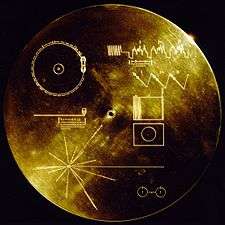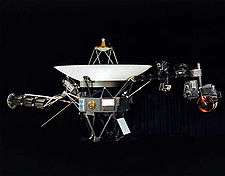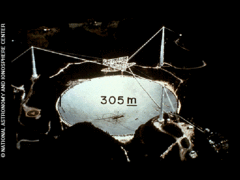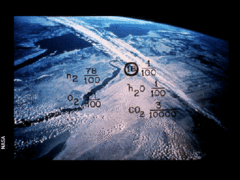Voyager Golden Record



The Voyager Golden Records are phonograph records that were included aboard both Voyager spacecraft launched in 1977. They contain sounds and images selected to portray the diversity of life and culture on Earth, and are intended for any intelligent extraterrestrial life form, or for future humans, who may find them. Neither Voyager spacecraft is heading toward any particular star, but Voyager 1 will pass within 1.6 light-years of the star Gliese 445, currently in the constellation Camelopardalis, in about 40,000 years.[1]
Carl Sagan noted that "The spacecraft will be encountered and the record played only if there are advanced space-faring civilizations in interstellar space. But the launching of this 'bottle' into the cosmic 'ocean' says something very hopeful about life on this planet."[2] Thus the record is best seen as a time capsule.
Background
The Voyager 1 probe is currently the farthest human made object from Earth. Voyager 1 has reached interstellar space, the region between stars where the galactic plasma is present.[3] Like their predecessors Pioneer 10 and 11, which featured a simple plaque, both Voyager 1 and Voyager 2 were launched by NASA with a message aboard — a kind of time capsule, intended to communicate to extraterrestrials a story of the world of humans on Earth.[2]
This is a present from a small, distant world, a token of our sounds, our science, our images, our music, our thoughts and our feelings. We are attempting to survive our time so we may live into yours.
Contents
The contents of the record were selected for NASA by a committee chaired by Carl Sagan of Cornell University. The selection of content for the record took almost a year. Sagan and his associates assembled 116 images and a variety of natural sounds, such as those made by surf, wind, thunder and animals (including the songs of birds and whales). To this they added musical selections from different cultures and eras, spoken greetings in 55 ancient and modern languages, and printed messages from U.S. president Jimmy Carter and U.N. Secretary-General Kurt Waldheim. The record also includes the inspirational message Per aspera ad astra in Morse code.
The collection of images includes many photographs and diagrams both in black and white, and color. The first images are of scientific interest, showing mathematical and physical quantities, the Solar System and its planets, DNA, and human anatomy and reproduction. Care was taken to include not only pictures of humanity, but also some of animals, insects, plants and landscapes. Images of humanity depict a broad range of cultures. These images show food, architecture, and humans in portraits as well as going about their day-to-day lives. Many pictures are annotated with one or more indications of scales of time, size, or mass. Some images contain indications of chemical composition. All measures used on the pictures are defined in the first few images using physical references that are likely to be consistent anywhere in the universe.
The musical selection is also varied, featuring artists such as Bach, Mozart, Beethoven, Stravinsky, Guan Pinghu, Blind Willie Johnson, Chuck Berry, Kesarbai Kerkar and Valya Balkanska. The inclusion of Berry's Johnny B. Goode was controversial, with some claiming that rock music was "adolescent", to which Sagan replied, "There are a lot of adolescents on the planet."[4] The selection of music for the record was completed by a team composed of Carl Sagan, Linda Salzman Sagan, Frank Drake, Ann Druyan, artist Jon Lomberg, and Timothy Ferris, who was an editor for Rolling Stone at the time.[5]
The Golden Record also carries an hour long recording of the brainwaves of Ann Druyan. During the recording of the brainwaves, Druyan thought of many topics, including Earth's history, civilizations and the problems they face, and what it was like to fall in love.
After NASA had received criticism over the nudity on the Pioneer plaque (line drawings of a naked man and woman), the agency chose not to allow Sagan and his colleagues to include a photograph of a nude man and woman on the record. Instead, only a silhouette of the couple was included.[6] However, the record does contain "Diagram of vertebrate evolution", by Jon Lomberg, with drawings of an anatomically correct naked male and naked female, showing external organs.[7]
The pulsar map and hydrogen molecule diagram are shared in common with the Pioneer plaque.
The 116 images are encoded in analogue form and composed of 512 vertical lines. The remainder of the record is audio, designed to be played at 16⅔ revolutions per minute.
Carl Sagan suggested that The Beatles song "Here Comes the Sun" be included on the record, but the record company EMI, which held the copyrights to the song, declined.[8]
In July 2015, NASA uploaded the audio contents of the record to the audio streaming service SoundCloud.[9]
Images
| Select images on the Voyager Golden Record | ||||||
|---|---|---|---|---|---|---|
|
|
Playback

In the upper left-hand corner is a drawing of the phonograph record and the stylus carried with it. The stylus is in the correct position to play the record from the beginning. Written around it in binary arithmetic is the correct time of one rotation of the record, 3.6 seconds, expressed in time units of 0.70 billionths of a second, the time period associated with a fundamental transition of the hydrogen atom. The drawing indicates that the record should be played from the outside in. Below this drawing is a side view of the record and stylus, with a binary number giving the time to play one side of the record – about an hour.
The information in the upper right-hand portion of the cover is designed to show how pictures are to be constructed from the recorded signals. The top drawing shows the typical signal that occurs at the start of a picture. The picture is made from this signal, which traces the picture as a series of vertical lines, similar to analog television (in which the picture is a series of horizontal lines). Picture lines 1, 2 and 3 are noted in binary numbers, and the duration of one of the "picture lines," about 8 milliseconds, is noted. The drawing immediately below shows how these lines are to be drawn vertically, with staggered "interlace" to give the correct picture rendition. Immediately below this is a drawing of an entire picture raster, showing that there are 512 (29) vertical lines in a complete picture. Immediately below this is a replica of the first picture on the record to permit the recipients to verify that they are decoding the signals correctly. A circle was used in this picture to ensure that the recipients use the correct ratio of horizontal to vertical height in picture reconstruction. Color images were represented by three images in sequence, one each for red, green, and blue components of the image. A color image of the spectrum of the sun was included for calibration purposes.
The drawing in the lower left-hand corner of the cover is the pulsar map previously sent as part of the plaques on Pioneers 10 and 11. It shows the location of the solar system with respect to 14 pulsars, whose precise periods are given. The drawing containing two circles in the lower right-hand corner is a drawing of the hydrogen atom in its two lowest states, with a connecting line and digit 1 to indicate that the time interval associated with the transition from one state to the other is to be used as the fundamental time scale, both for the time given on the cover and in the decoded pictures.[10]
Much like the Pioneer Plaque, controversy surrounded the complexity of the record and its accompanying stylus.
Materials
The record is constructed of gold-plated copper and is 12 inches (30 cm) in diameter.[2] The record's cover is aluminum and electroplated upon it is an ultra-pure sample of the isotope uranium-238. Uranium-238 has a half-life of 4.468 billion years. It is possible (e.g. via mass-spectrometry) that a civilization that encounters the record will be able to use the ratio of remaining uranium to the other elements to determine the age of the record.
Inscription
The records also had the inscription "To the makers of music – all worlds, all times" hand-etched on its surface. The inscription was located in the "takeout grooves", an area of the record between the label and playable surface. Since this was not in the original specifications, the record was initially rejected, to be replaced with a blank disc. Sagan later convinced the administrator to include the record as is.[11]
Journey

Voyager 1 was launched in 1977, passed the orbit of Pluto in 1990, and left the solar system (in the sense of passing the termination shock) in November 2004. It is now in the Kuiper Belt. In about 40,000 years, it and Voyager 2 will each come to within about 1.8 light-years of two separate stars: Voyager 1 will have approached star Gliese 445, located in the constellation Camelopardalis; and Voyager 2 will have approached star Ross 248, located in the constellation of Andromeda.
In March 2012, Voyager 1 was over 17.9 billion km from the Sun and traveling at a speed of 3.6 AU per year (approximately 61,000 km/h (38,000 mph)), while Voyager 2 was over 14.7 billion km away and moving at about 3.3 AU per year (approximately 56,000 km/h (35,000 mph)).[12]
Voyager 1 has entered the heliosheath, the region beyond the termination shock. The termination shock is where the solar wind, a thin stream of electrically charged gas blowing continuously outward from the Sun, is slowed by pressure from gas between the stars. At the termination shock, the solar wind slows abruptly from its average speed of 300–700 km/s (670,000–1,570,000 mph) and becomes denser and hotter.[13]
Of the eleven instruments carried on Voyager 1, five of them are still operational and continue to send back data today. It is expected that there will be insufficient energy to power any of the instruments beyond 2025. After that, the spacecraft will continue to traverse the Milky Way galaxy.
On September 12, 2013, NASA announced that Voyager 1 had left the heliosheath and entered interstellar space,[14] although it still remains within the Sun's gravitational sphere of influence.
Depictions in culture
Several works of science fiction, such as the 1979 film, Star Trek: The Motion Picture, the 1984 film Starman and the 2000 film Battlefield Earth feature extraterrestrial intelligences discovering the record and turning their attention to Earth as a result. Among these is included the computer animated television show, Beast Wars, which features one of the records as a central plot point in a continuation of the Transformers storyline.
The recording is a major plot piece of "Little Green Men", a season 2 episode of The X Files.
In a Saturday Night Live segment ("Next Week in Review") in episode 64 of the show's third season (originally aired 1978), Steve Martin's character, a psychic named Cocuwa, announced that extraterrestrials had responded to the record with the four words "Send more Chuck Berry".[15]
In 2014, The Truth (podcast) produced an episode titled "Voyager Found", where the Voyager crash-lands on the property of Dawn and Tad, an alien couple, who decide to play the record.[16]
The 2015 feature documentary Sam Klemke's Time Machine compares the Golden Record's portrait of humanity to American man Sam Klemke's ongoing self-portraiture. In 1977 - the same year that NASA launched Voyager with the Golden Record - Sam started obsessively documenting his entire life on film. Sam Klemke's Time Machine, directed by Matthew Bate, premiered at the 2015 Sundance Film Festival.[17][18]
In October 2016 the podcast Science Friday featured an updated, crowd sourced version of the Golden Record which included, amongst other entries, I Have a Dream, The Little Prince, and the human genome.[19]
Publications
Most of the images used on the record (reproduced in black and white), together with information about its compilation, can be found in the 1978 book Murmurs of Earth: The Voyager Interstellar Record by Carl Sagan, F.D. Drake, Ann Druyan, Timothy Ferris, Jon Lomberg, and Linda Salzman.[20] A CD-ROM version was issued by Warner New Media in 1992.[21] The CD-ROM was the result of Sagan's diligence in obtaining copyright clearances for many of the numerous musical passages and photographs that the original Golden Record contained, to allow for their inclusion in the Warner New Media release. Author Ann Druyan, who later married Carl Sagan, wrote about the Voyager Record in the epilogue of Sagan's final book Billions and Billions.[22]
See also
References
- ↑ "Voyager – Interstellar Mission". Jet Propulsion Laboratory. NASA. January 25, 2010.
- 1 2 3 "Voyager – Golden Record". NASA. Retrieved September 23, 2010.
- ↑ "NASA Spacecraft Embarks on Historic Journey Into Interstellar Space". NASA. September 12, 2013. Retrieved April 15, 2014.
- ↑ "What Is on Voyager's Golden Record?". Smithsonian. Retrieved 2015-12-07.
- ↑ "What Is on Voyager's Golden Record?". Smithsonian. Retrieved 2015-12-07.
- ↑ Jon Lomberg, "Pictures of Earth". In Carl Sagan, Murmurs of Earth, 1978, New York, ISBN 0-679-74444-4
- ↑ "Voyager Record Photograph Index". NASA. Retrieved December 20, 2014.
- ↑ "Kvart & Bølge - Audiophile Quarter-Wave Full-Range Speakers -". Kvart & Bølge - Audiophile Quarter-Wave Full-Range Speakers -. Retrieved November 30, 2015.
- ↑ "NASA". SoundCloud. Retrieved 2016-04-20.
- ↑ "Voyager Record". NASA. Retrieved May 26, 2010.
- ↑ Ferris, Timothy (September 5, 2007). "The Mix Tape of the Gods". New York Times. Retrieved February 11, 2009.
- ↑ "Voyager – The Interstellar Mission". NASA. Retrieved November 26, 2012.
- ↑ "NASA - Voyager Enters Solar System's Final Frontier". Retrieved November 30, 2015.
- ↑ "NASA Spacecraft Embarks on Historic Journey Into Interstellar Space". NASA. Retrieved November 30, 2015.
- ↑ "Saturday Night Live Transcripts, Season 3: Episode 18, 77r: Steve Martin / The Blues Brothers, Next Week In Review". Season 3: 1977-1978. April 22, 1978. Lay summary.
- ↑ http://www.thetruthpodcast.com/story/2015/10/6/voyager-found
- ↑ Harvey, Dennis. "Sundance Film Review: 'Sam Klemke's Time Machine'". Retrieved 15 April 2016.
- ↑ "Sundance Institute". Retrieved November 30, 2015.
- ↑ "Your Record". Science Friday. 2016-10-07. Retrieved 2016-10-07.
- ↑ Sagan, Carl et al. (1978) Murmurs of Earth: The Voyager Interstellar Record. New York: Random House. ISBN 0-394-41047-5 (hardcover), ISBN 0-345-28396-1 (paperback)
- ↑ Sagan, Carl et al. (1992) Murmurs of Earth (computer file): The Voyager Interstellar Record. Burbank: Warner New Media.
- ↑ Sagan, Carl (1997). Billions and Billions: Thoughts on Life and Death at the Brink of the Millennium. Random House. ISBN 0-679-41160-7.
- Originally based on public domain text from the NASA website, where selected images and sounds from the record can be found.
External links
| Wikimedia Commons has media related to Voyager Golden Record. |
- Official NASA JPL page about the Golden Record
- Multimedia showcase with the contents of the Golden Record
- Web site with all of the images, languages, and sounds on the Record.
- The Infinite Voyager : The Golden Record - built by Lily Bui from MIT
- Voyager 1 Audio on Internet Archive
- Cosmic Journey: The Voyager Interstellar Mission and Message
- U Iowa website with Termination Shock information
- John Cohen and the Voyager Record from The Celestial Monochord
- Article on Ithaca, NY connections to the Voyager Record, 30th anniversary, page 11
- NYT 30th Anniversary OP-ED article by Timothy Ferris, who supervised the production of the disc
- NPR.org: Voyagers' Records Wait for Alien Ears
- WNYC Radiolab interview with Ann Druyan on her role in the making of the Voyager Record, May 12, 2006
- Smithsonian National Air and Space Museum's Voyager Record Cover
- Interview with Jon Lomberg on Australia's Radio National The Science Show, November 19, 2005





